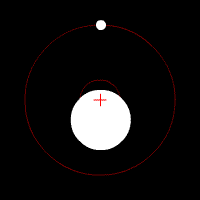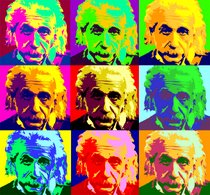“Albert, this solar system we're about to explore, is this the only one?”
Well there was a time when some people thought so. Even the nearest stars are so far off that seeing a planet around another star seemed impossible.
“But you told me that I should try to believe in the impossible.”
Exactly, and that's what astronomers did when they went searching for planets circling far off stars.
“Did they just build bigger telescopes?”
No, they had to think how they could detect something that they couldn't see and they worked out the answer a long time before they found the first planet.
“How did they manage it?”
Well the first way they discovered was to look tiny wobbles in the position of a star?
“How does that help?”
Imagine an ice-skater spinning on the ice. On their own he or she can spin on just one spot.
“So?”
Well, what happens if two skaters are hold hands and spinning. They can't both spin on the same spot can they?
“No, but I'm not sure where you are going with this Albert.”
It will become clear don't worry. Two skaters holding hands will spin in a circle, with the middle of the circle between them. So imagine one very large, fat skater and a tiny little one, if they held hands they would spin in a circle too, but the centre of that circle would be close to the fat skater.
“OK, but we are talking about discovering planets aren't we?”

Of course we are and that is how they discovered the first planets outside our solar system. Imagine you are looking at the fat and tiny skater from a distance, you might only be able to see the fat one but you could tell there had to be another skater there because they would be wobbling slightly. So that is what astronomers did, they looked for stars that seemed to be wobbling from side to side in space. Some people claimed to have found wobbling stars that must have planets going around them as long ago as 1855, but it wasn't until 1988 that three Canadian astronomers, Bruce Campbell, G. A. H. Walker, and S. Yang found the first definite star with a planet in the constellation Cepheus.
“Where's that?”
It's a constellation that looks like a house up near the pole star. This famous star with the first detected planet is the called Alrai (or gamma Cephei) and in terms of the constellation it makes up the top of the roof. It is one brighter stars near the pole star so in Autumn and Winter if you live in the northern hemisphere look up above and a little bit north and you'll see it.
“Will I be able to see it wobbling?”
It might be twinkling like any other star but the wobble is so tiny it can only be detected in photographs taken by the largest telescopes on earth.
“Is that the only planet they've found so far?”
Not at all, once they found the first one other astronomers started looking more seriously. There are now over two hundred planets detected and they are finding 40 or more every year now. The fact they are finding so many planets tells us that the universe is probably full of stars with planets.
“So where do they all come from these planets?”
Come from? The view these days is that both the sun and the planets formed at a similar time from a swirling disc of gas and interstellar debris. As things started to cool down gravity helped to collect most of the gas into the centre which became the sun. Gravity also collected the left overs and debris into planetoids and then planets.
“Are they aliens on these planets?”
No-one knows, but most of the planets that have been discovered so far are huge planets very different to earth so it's unlikely they have anyone like us on them. But they have just discovered a planet in the Goldilocks zone, where earth-like life could exist.
“The Goldilocks zone?”
From Goldilocks and the three bears, where Goldilocks found a porridge that was just right, not too hot and not too cold. If a planet is too close to its star it will be too hot and if it is too far away from the star it will be too cold. So there is a zone around every star that is now called the Goldilocks zone where the temperature would be just right for life, somewhere between 0 and 40 degrees Celsius. The planet they have just discovered around a star called Gliese 581, is in just the right place and seems to be a rocky planet like earth and only a little bit bigger.
 “What's the planet called?”
“What's the planet called?”It's scientific name is Gliese 581c, but it has been given the name Ymir. It also has two other planets, so it is really like another solar system.
“So the aliens would be called Ymirians then?”
You and your aliens! Well, we don't know for sure that there is any water on Ymir, but as Xavier Delfosse, one of the team that discovered it said, “on the treasure map of the universe one would be tempted to mark this planet with an X.”
“So is anyone sending a space ship there?”
It's still 20.5 light years away so there is no way humans could get there at the moment, but a radio or TV signal could get there in 20.5 years. So the TV pictures from the moon landings would have reached them in about 1990. Perhaps if they exist and are impressed by our first attempts at space travel they might send us a message back.
“When could that message reach us?”
If they didn't spend too long thinking about it, a message could get back to us by about the year 2010..
“Are you serious?”
Not very often, but it is nice to think that it is at least possible.







